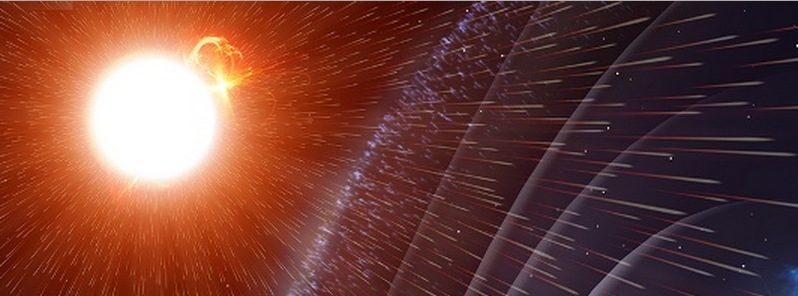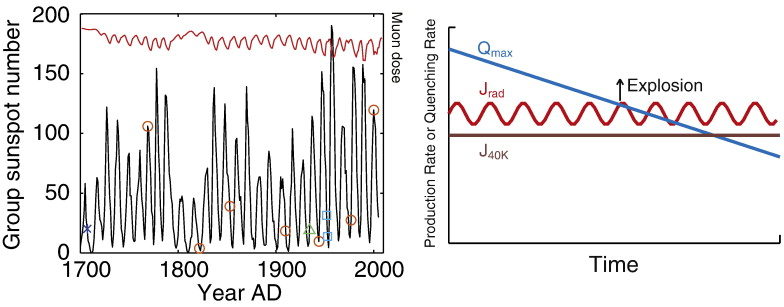Volcanoes with silica-rich and highly viscous magma tend to produce violent explosive eruptions that result in disasters in local communities and that strongly affect the global environment.
We examined the timing of 11 eruptive events that produced silica-rich magma from four volcanoes in Japan (Mt. Fuji, Mt. Usu, Myojinsho, and Satsuma-Iwo-jima) over the past 306 years (from AD 1700 to AD 2005). Nine of the 11 events occurred during inactive phases of solar magnetic activity (solar minimum), which is well indexed by the group sunspot number.This strong association between eruption timing and the solar minimum is statistically significant to a confidence level of 96.7%. This relationship is not observed for eruptions from volcanoes with relatively silica-poor magma, such as Izu-Ohshima. It is well known that the cosmic-ray flux is negatively correlated with solar magnetic activity, as the strong magnetic field in the solar wind repels charged particles such as galactic cosmic rays that originate from outside of the solar system.
The strong negative correlation observed between the timing of silica-rich eruptions and solar activity can be explained by variations in cosmic-ray flux arising from solar modulation. Because silica-rich magma has relatively high surface tension (similar to 0.1 Nm(-1)), the homogeneous nucleation rate is so low that such magma exists in a highly supersaturated state without considerable exsolution, even when located relatively close to the surface, within the penetration range of cosmic-ray muons (1-10 GeV).
These muons can contribute to nucleation in supersaturated magma, as documented by many authors studying a bubble chamber, via ionization loss. This radiation-induced nucleation can lead to the pre-eruptive exsolution of H2O in the silica-rich magma.
We note the possibility that the 1991 Mt. Pinatubo eruption was triggered by the same mechanism: an increase in cosmic-ray flux triggered by Typhoon Yunya, as a decrease in atmospheric pressure results in an increase in cosmic-ray flux.We also speculate that the snowball Earth event was triggered by successive large-scale volcanic eruptions triggered by increased cosmic-ray flux due to nearby supernova explosions.
Graphical abstractAn anti-correlation of silica-rich magma eruptions and solar magnetic activity is found:
Eight out of eleven eruptions took place in the period when the sun is not active. This anti-correlation suggests that silica-rich magma eruptions are triggered by bubble nucleation in magma, induced by cosmic-ray muons. Violent destruction of magma dome in a conduit is triggered when production rate,
Jrad, of the possible nucleation site exceeds the quenching rate,
Qmax.
Research Highlights
► An anti-correlation of silica-rich magma eruptions solar magnetic activity is found. ►Nucleation of bubbles in supersaturated magma, induced by cosmic-ray muons, may lead to an explosive eruption. ► 1991 Mt. Pinatubo eruption may be triggered by an increase in cosmic-ray flux by Typhoon.


Reader Comments
to our Newsletter